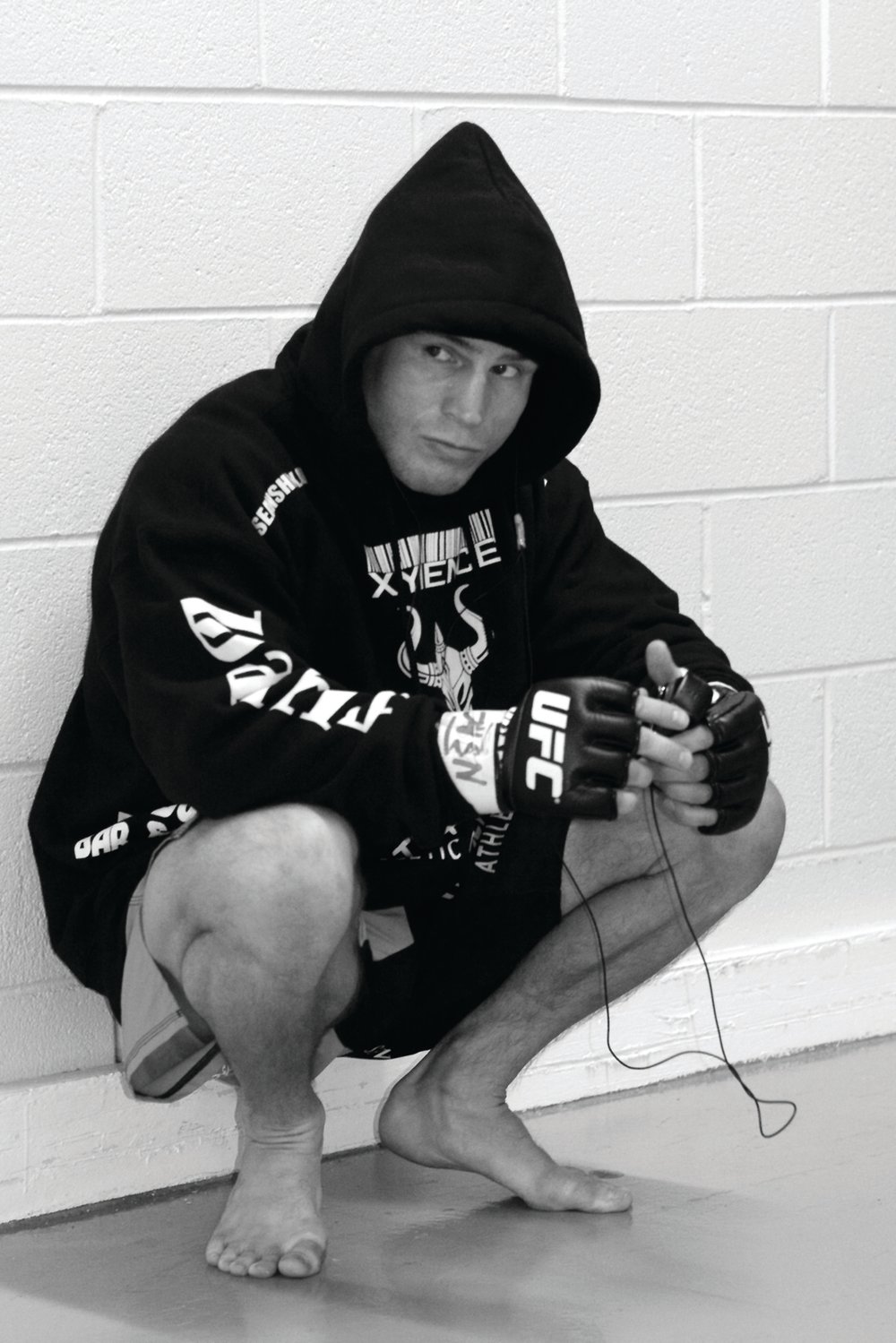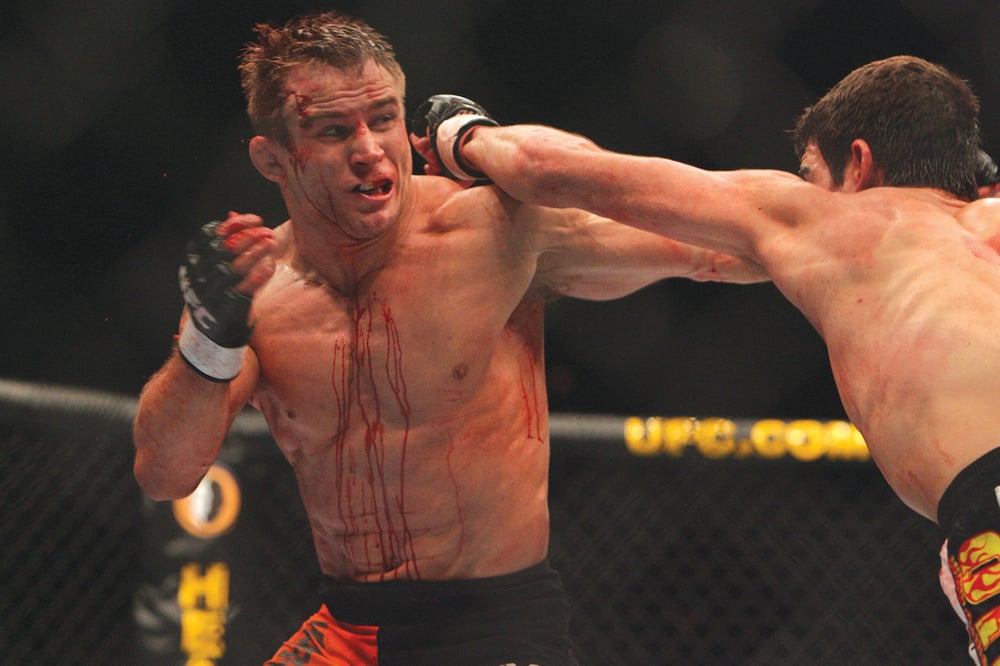
Issue 023
March 2007
Sean ‘The Muscle Shark’ Sherk is widely regarded as one of the most dedicated athletes known to the sport of Mixed Martial Arts.
?Fighting professionally since 1999 and competing up to eight times a year, Sean has slammed and smashed his way through the US MMA circuit, only twice tasting defeat in his career. A smart tactical move recently saw Sean drop down to the 155lb division and come through a blood-soaked war with Kenny Florian, fulfilling his dream of capturing a UFC title belt. Taking some time off to recover from a serious shoulder injury, Sean spoke candidly with Jim Page about his love of competition and his single-minded pursuit of some ambitious career goals.
As with many fighters growing up in the US, Sean’s introduction to competition came at an early age; ‘I started wrestling when I was 7 years old… pretty much lived and breathed it my whole life. I wrestled until I was 19 years old. I never wrestled competitively at college; I actually started training mixed martial arts right out of high school. So around 1994 I started training mixed martial arts and continued my wrestling.’
Sean clearly feels that this wrestling background gives him a real edge in competition, as he explained; ‘It gives me a lot of advantages, it lets me dictate where the fight is going to take place. If I want to stand up and trade punches, I’m going to be real, real hard to take down and if I want to take a fight to the ground, I’m going to be able to do that as well. Also, just as far as work ethic goes, there’s no athlete in the world who has a work ethic the way wrestlers do. The wrestling room is so intense and that crosses over into the martial arts as far as training and fighting goes.’
Having always dabbled in boxing and knowing the importance of the stand-up game, Sean outlined his theory on how best to set up spine-rattling slams; ‘You want to get the guy thinking about something else… if you just shoot, ‘shooting dry’ - that’s what I call shooting without throwing a punch - you’re going to be a lot less successful without throwing a punch first. You’ve got to give the guy something to think about, throw some punches, make him cover his head. It catches them off guard, shoot while he’s covering up from your punches.’
Labeled as ‘just a wrestler’ by some observers, Sean was keen to stress that he has been working on submissions for many years; ‘I’ve been training jiu-jitsu for 12 years, a lot of people don’t know this, everyone calls me a wrestler and some people say that I don’t have any jiu-jitsu, but they just don’t know. Unless you’ve stepped on the mat with me, you don’t know what my jiu-jitsu is like. I’ve been training since 1994, I’ve got an extensive background in submission; I’ve had 38 fights and I’ve never been submitted. My game has evolved a lot, when I first stepped on the mat I was 100% wrestler, but now I feel real confident… In pretty much every position I’m in I feel like a threat - if not for a submission, then for a reversal, or a mount or something of that nature; I learned the game real well.’
Building on his skills all the time, Sean is confident that he has the right people around him to help create the perfect atmosphere for fight preparation; ‘I’ve been training at the same school since 1994. I knew I was in the right place the second I walked in the door, literally, within 5 minutes of walking in the door I knew that that was where I was going to stay. My trainer’s name is Greg Nielsen; he’s a former wrestler at the University of Minnesota, Black Belt in Jiu-Jitsu and Thai boxer. He’s just a phenomenal coach and has been a big part of my success, not just through his teaching but also through motivational techniques. I love the school… it’s the first place I started training and it’s going to be the last place I ever train, I’ll never leave. The are a lot of great students, fighters like Nick Thompson, Brock Larson, Dave Menne, we got [Former WWE wrestler] Brock Lesnar training with us, we got a lot of really solid up-and-coming guys so it’s a great place to train.’
Unfortunately for Sean, he has not had the opportunity to work with his training partners since he underwent surgery on his shoulder after his fight with Kenny Florian. ‘I’ve had a lot of injuries over the years, most of them were nagging injuries – I’ve never had a break or anything of that nature that would force me to require surgery; this is actually my first one. The injury took place about a week before the fight; I tore my shoulder. I knew it was torn, but there’s nothing you can do about it, you’ve come way too far and this was my second opportunity for a UFC title, so I’m pretty much going to fight regardless.’

Asked how he managed to cope with the strain of going into a championship fight carrying a serious injury, Sean went through the difficulties he faced; ‘You know it really did take a mental toll on me the week of the fight because I wasn’t able to do anything, I was in a lot of pain; I wasn’t sleeping at all, it was keeping me up all night. I’m one of those guys who won’t take aspirin or anything like that because it upsets my stomach. I had no painkillers at all. So, mentally, it did take a big toll on me but that’s what my training partners and coaches are there for. I’d trained so hard for that fight, so the hard part was already done, the last bit is mental, so they did a good job of making me realize that it was my time to shine and my time to win a fight. The really weird thing was, as soon as I stepped in the octagon I didn’t feel any pain at all, the shoulder went completely numb – it was like my body knew; “It’s time to go!”’
Reflecting on his win over Florian, the biggest of his career, Sean was respectful about his opponent’s skills; ‘He’s a tough guy, got some great jiu-jitsu, got some good striking – I pretty much knew that he was an all-round type of a guy. The first thing I really remember from the fight was originally when I first grabbed onto him. My entire career has been at 170lbs, I used to fight guys who were 15-20 pounds heavier than me every single time I fought. It felt good, because I thought “OK, this guy’s smaller than me, he’s not going to be as strong as I am.” So that’s a big advantage.’
Early in the fight, however, Kenny landed a short elbow to Sean’s temple, causing a nasty gash that poured blood continuously over the remaining rounds; ‘The cut was a big issue, obviously, bleeding a lot makes it real slippery, hard to hang onto. But, [mentally] it had no impact on me at all. I didn’t even think about it, didn’t care about it. Soon as I was cut the referee looked at me and said, ‘You’re fine.’ The doctor looked at me and said ‘You’re fine.’ And that’s the last I thought about it. Obviously the blood took a toll, but I was so focussed on the fight that I didn’t even think about the cut once.’
Surprisingly, the prospect of sustaining injuries or taking punishment in the fight seemed only to have a motivational effect on Sean, ‘All in all, man, like I said before the fight, if I win the world title, I want to go in there and I want to go to war, and I want my hand to be raised afterwards and I want to know that I just earned this world championship. I don’t want to walk out and knock somebody out in 5 seconds and win a world title, I want to go to war to win a world title and that’s pretty much what happened.’
‘I was so prepared. I had 7 months to prepare for this fight. Twice within a 3 month period I cut down to 155 just to make the weight so I could get my body acclimated to it. The first time I made the cut was awful, the second time I felt a little better, third time I made the cut was fight day and I felt great, never felt better. The best thing I did throughout that process was do those trial cuts. It sucks – by all means; it sucks cutting 20, 25lbs just for practice. A lot of people aren’t willing to do that, but it’s something that has to be done.’

After an 11-month break from the sport, Sean’s return to the UFC roughly coincided with the reintroduction of the UFC Lightweight division, a development that has been a huge bonus to his career; ‘I’m here to stay, I’m not going back up to 170. I’ve no reason to; I’ve found my home at 155, so I’m not going anywhere. Next time I leave it will probably be for good and I don’t plan on retiring for a long time. I still feel like I’m at the top of my game, I’m 33 years old and I’ve never felt better. Technically, I’m still getting better, I haven’t lost any speed – I’ve actually got faster, I’ve got stronger, my endurance is better. So like I said, I’m not going anywhere for a long time.’
Afraid of no challenge in the fight game, Sean spoke of his willingness to fight anyone put in front of him; ‘I’ve always been one of those guys who’s willing to fight anyone they throw in the cage with me. I don’t want to pick and choose my opponents. I want to fight the best guys in the world. Ultimately, when my career is over I want to look back and know I fought the best guys in the world, I want to know that I beat the best guys in the world and I want to know that I was the best guy in the world. I don’t want any question marks about my career when it’s over with. So I’m pretty much going to fight whoever they put in the cage with me, I really don’t care.’
That said, with a moments pause, Sean went on to reveal a fighter he has a great professional interest in facing; ‘Actually, I was reading in an interview that [Pride Lightweight Champion, Takanori] Gomi was talking smack, saying he’d beat me easily. After I read that, the hairs on the back of my neck started standing up. I hope the UFC bring Gomi over. I’d love to fight him; I think he’s made to order for me to be honest with you. He’s got heavy hands, but he can’t sprawl and he’s got no jiu-jitsu. I’d love to fight that guy and shut his mouth up.’
Asked as a final question what he does to keep himself amused away from the mat, Sean left a distinct impression of how he leads his life as a dedicated champion; ‘When I’m not training, for the most part, I just like to chill with my two kids, catch up on sleep and relax. I do a lot of rehab, and chiropractic acupuncture. My life revolves around fighting, so everything I do has got to be something to do with preparing my body, preparing my mind or training for a fight, that’s all I do, 7 days a week, pretty much 365 days a year.’










